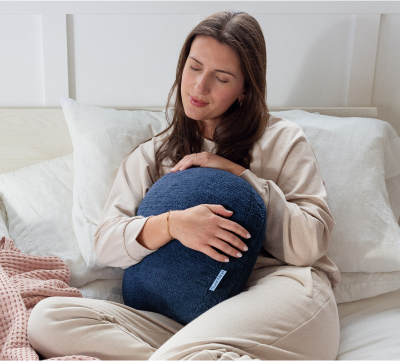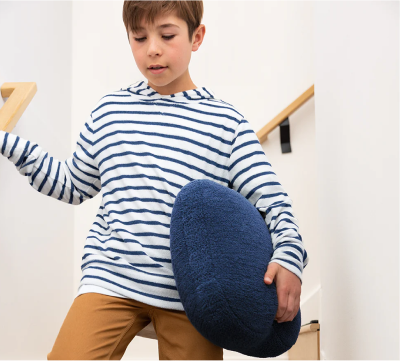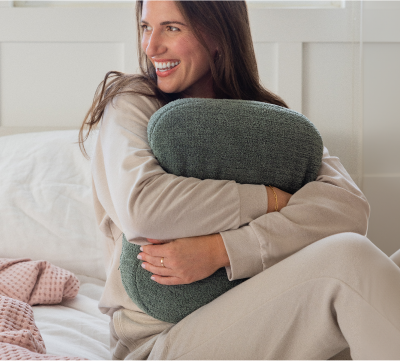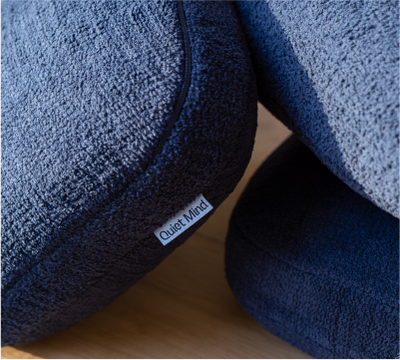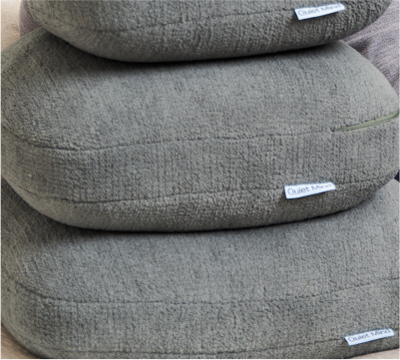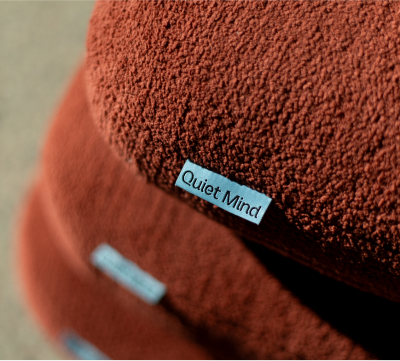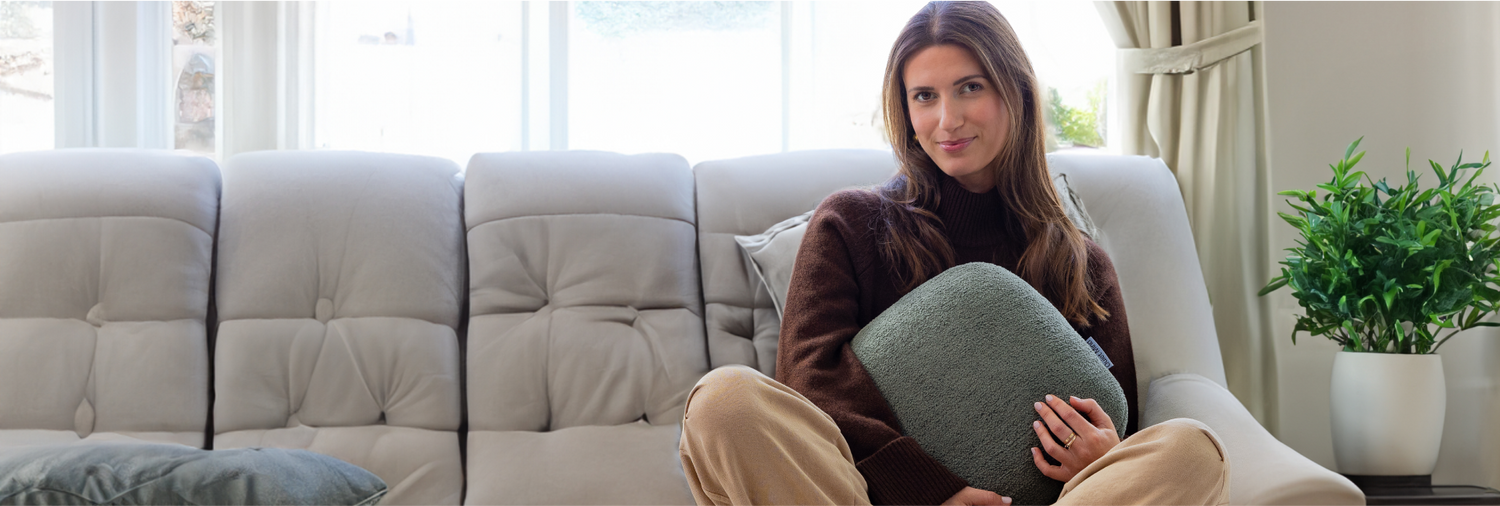Dogs don’t overthink rest. They don’t delay sleep with worry or fill their evenings with noise. They stretch, settle, and simply drift because their bodies ask, and they listen.
Watching a dog sleep can feel like witnessing presence in its purest form. But beyond the calm exterior lies a deeply responsive rhythm: sleep that flows with need, not schedule.
By observing how and when dogs sleep, we gain more than appreciation, we get a mirror. Their natural cycles offer quiet lessons about how our own bodies crave rest, too. Not as a reward. But as a return.
Understanding Dog Sleep Cycles and Patterns
Understanding dog sleep is to understand one thing clearly; for them rest is not optional, it’s foundational.
How Long Do Dogs Sleep in a Day?
Most dogs sleep between 12 and 14 hours a day. Puppies, seniors, and large breeds often sleep even more, up to 20 hours in some cases. Unlike humans, dogs spread their sleep throughout the day in short, intentional pauses.
Their rest isn't fragmented, it's responsive. They nap after walks, play, meals, and even moments of excitement. Rest is not something they wait for. It's something they return to.
Stages of Sleep in Dogs: REM and Non-REM
Dogs cycle through two primary sleep stages:
- Non-REM sleep: In this sleep body restores itself, heart rate slows, muscles relax, breathing deepens.
- REM sleep: The brain lights up. You might see paws twitch, eyes dart beneath closed lids, or hear soft whimpers. This is the dreaming phase, tied to memory and emotional processing.
Dogs experience shorter sleep cycles than humans, moving in and out of REM more frequently. This means they wake easily, nap often, and sleep lightly, traits shaped by evolution.
How Human Sleep Cycles Compare to Dog Sleep Patterns
While we share similar architecture, light sleep, deep sleep, REM, our patterns diverge in rhythm.
Differences in REM Frequency and Sleep Duration
Humans typically enter REM sleep every 90 minutes. Dogs reach it every 20 minutes, which means they dream more often but for shorter periods.
Dogs also don’t consolidate sleep into one long session. Instead, they nap in cycles, returning to rest when needed. For them, sleep is fluid. For humans, it’s often rigid, scheduled, delayed, sometimes resisted.
Why Dogs Wake Easily and Sleep Often
Dogs are biologically wired to remain lightly alert. As both predator and prey throughout history, they evolved to rest without fully surrendering awareness. Even at rest, they listen.
Their frequent naps help them recover from bursts of energy. Their instincts remind us that recovery isn’t laziness, it’s part of balance.
What Your Dog’s Sleep Can Teach You About Rest
Your dog doesn’t ask permission to nap. They don’t wait for the “right time” to rest. They don’t power through fatigue. And maybe that’s the lesson.
The Value of Frequent Napping and Rest Pauses
Short, intentional pauses throughout the day, like your dog’s naps, can:
- Improve mood and concentration
- Support physical recovery
- Prevent late-night overstimulation
Think of these moments not as indulgences, but as returns to balance.
Listening to Your Body Like Your Dog Does
Dogs notice their own fatigue and respond. Humans often override those signals with caffeine, screens, or urgency.
Learning to recognize early signs of tiredness and act on them; whether by napping, stretching, or simply pausing, can help regulate your sleep at night and improve your energy during the day.
Why We Ignore Tiredness and What It Costs Us
Unlike dogs, we often push through the first signs of fatigue. Deadlines, stimulation, and internal pressure convince us to override rest signals.
- Skipping rest doesn’t build resilience, it builds exhaustion debt.
- Overriding tiredness during the day often leads to second winds at night, making sleep harder to access when you actually need it.
- Chronic suppression of rest signals can disconnect you from your body’s natural rhythm.
Relearning the Art of Rest Without Earning It
Dogs don’t have to “deserve” a nap, they trust their body’s cues.
- For humans, rest is often postponed until productivity is “justified.”
- Shifting your mindset toward permission-based rest, pausing even when everything isn't done, can reset nervous system tone and reduce evening hyperarousal.
- Even small acts like closing your eyes for 3 minutes or stepping away from a screen can act as a nervous system reset.
Adapting Lessons from Canine Sleep to Improve Human Sleep
We don’t have to sleep exactly like dogs to learn from them. But we can soften our relationship with rest for better sleep.
Embracing Natural Rest Rhythms
Rather than forcing sleep at fixed hours, try:
- Following tiredness, not the clock.
- Letting go of productivity during moments of fatigue.
- Welcoming rest as rhythm, not interruption.
Rhythms vary. Rest becomes sustainable when it feels personal and aligned.
Prioritizing Sleep Quality Over Quantity
Your dog doesn’t count hours, they respond to need. Likewise, a full night of shallow sleep does not restore the body as effectively as a shorter night of deep, high-quality rest.
To support quality sleep over quantity:
- Keep your sleep space quiet, dark, and undisturbed
- Avoid stimulating activities close to bedtime
- Try calming rituals: reading, deep breathing, or simply dimming the lights
Letting Go of Sleep Perfectionism
Many people chase the “perfect” 8-hour block, but just like dogs, humans benefit from sleep flexibility.
- Not every night needs to be identical.
- Restlessness doesn’t mean failure, it's information.
- Some nights are for deep sleep, others for quiet wakefulness.
Releasing pressure allows rest to unfold more naturally.
Listening to Your Body’s Cues
Dogs lie down when they’re tired; no guilt, no second-guessing.
- Notice signs of fatigue: eye strain, irritability, zoning out.
- Honor micro-rests during the day: short breaks, quiet pauses.
- Let drowsiness, not the clock, guide bedtime when possible.
Building body-awareness restores trust in your internal sleep signals.
Creating a Sleep-Friendly Environment (Like a Den)
Dogs instinctively seek cozy, quiet places to sleep. Your environment shapes your ability to relax.
- Keep the lighting soft in the evening.
- Use scents (like lavender) to signal safety and rest.
- Limit noise, clutter, and screen exposure in the hour before bed.
Think of your bedroom like a sanctuary, not just a utility space.
These simple shifts can help fix odd sleep habits by realigning you with your natural rhythm, something your dog follows effortlessly.
Quiet Mind products, like a scented weighted pillow can become part of that gentle ritual.
Signs of Healthy Sleep in Dogs (and Why They Matter for You)
You can often tell when a dog has slept well. Their energy, responsiveness, and emotional stability reveal it.
Behavior Clues That Show Dogs Are Well-Rested
A well-rested dog:
- Engages willingly in play and training
- Eats with enthusiasm
- Responds quickly to cues
- Shows calm affection rather than agitation
These signs remind us that sleep shapes not just energy, but emotional clarity.
What Human Sleep Struggles May Reflect by Comparison
Humans also reveal their sleep quality in subtle ways:
Just like dogs, our sleep or lack of it, shows up in how we move through the world. But many of us are so used to exhaustion that we miss the signs until they become overwhelming.
Here’s how common human sleep struggles might show up and what a more rested state could look like by comparison:
|
Area |
When Sleep Is Lacking |
When Sleep Is Restorative |
Parallels in Dogs |
|
Energy |
You drag through the day, rely on caffeine, or feel foggy |
You feel motivated, curious, able to focus |
Dogs bounce, explore, nap naturally |
|
Mood |
You’re irritable, reactive, or emotionally numb |
You respond with more patience and warmth |
Well-rested dogs are affectionate and even-tempered |
|
Health |
You get sick often, skin breaks out, appetite fluctuates |
Your immunity stabilizes, digestion improves |
Healthy dogs show a shiny coat and steady appetite |
Instead of pushing through, your body may be quietly signaling what it needs, just like a dog who simply lays down when tired. Recognizing these patterns is the first step in reshaping your relationship with rest.
How to Read Your Dog’s Sleep Signals
Dogs “speak” through behavior, even in sleep. When they shift sleep positions, twitch, or sigh deeply, they’re offering cues.
Observing Patterns and Shifts
- Duration: Most dogs need 12–14 hours a day.
- Quality: A dog that wakes easily and stretches calmly likely feels safe and restored.
- Changes: Sudden restlessness or excessive sleep may signal discomfort or stress.
Awareness builds connection. It also invites reflection: What is your own sleep saying back to you?
Should You Sleep with Your Dog?
The question of co-sleeping is personal. It has emotional and practical layers.
Pros and Cons of Sleeping with Your Dog
Sharing your bed with your dog can feel comforting, but it’s not always restful. Here’s a more detailed look at the benefits of emotional and physical trade-offs:
|
Aspect |
Benefits |
Challenges |
|
Emotional Comfort |
Provides warmth, companionship, and reduces nighttime anxiety |
May create dependency that makes solo sleep harder in the long term |
|
Sleep Quality |
Can help you fall asleep faster through emotional calming |
May lead to disturbed sleep from movement, snoring, or shifting positions |
|
Health & Allergies |
Comforting during illness or emotional distress |
Pet dander, hair, or outdoor allergens can aggravate symptoms |
|
Bonding |
Strengthens emotional connection between pet and owner |
May unintentionally reinforce territorial behavior in dogs |
|
Sleep Environment |
Brings emotional warmth to your sleeping space |
Takes up space, increases heat retention, and may crowd smaller beds |
Tips for Harmonious Co-Sleeping
Want the closeness without compromising your rest? Here’s how to strike a healthy balance:
-
Establish consistent sleep routines for both of you: Dogs thrive on structure. Aim to go to bed and wake up at the same time every day, including weekends. Doing so helps regulate your circadian rhythm and your dog’s internal clock, reducing middle-of-the-night pacing or restlessness.
-
Keep bedding and air clean and allergen-free: Wash sheets weekly and use hypoallergenic covers on pillows and mattresses. Consider using an air purifier with a HEPA filter to reduce dander, pollen, and dust in the bedroom, especially important if your dog spends time outdoors.
-
Use a designated side or pet bed: If full co-sleeping feels too disruptive but you still want closeness, place a dog bed adjacent to yours. Some dogs prefer independence once they have their own soft, safe spot, and it can improve your quality of sleep dramatically.
-
Set gentle boundaries: Train your dog to stay on one side of the bed or avoid crowding your pillow area. If they tend to jump up and down during the night, practice a cue like “settle” or “bedtime” as part of your routine.
- Monitor your own sleep health: If you find yourself waking up groggy, with aches, or in a poor mood, consider tracking your sleep with an app or journal. This can help you spot patterns and decide if co-sleeping is enhancing or hindering your rest.
Ultimately, sleeping with your dog is about rhythm. If it supports rest, it can be part of your routine.
Tips for Synchronizing Your Sleep Habits with Natural Cycles
If you often can’t sleep even though you're tired, your environment may be sending mixed signals to your body. Dogs respond to the environment: light, motion, temperature, and food. We do too, though often unconsciously.
Creating a Dog-Like Wind-Down Routine
Before sleep, dogs stretch, sigh, circle, and settle.
Your version might include:
- Gentle movement, stretching, yoga, or walking
- Dimming lights an hour before bed
- Turning off screens and engaging in something tactile, like journaling or a book
These simple cues help your nervous system shift from alert to rest, making it easier to fall asleep faster and more naturally, just like dogs instinctively do.
Using Light, Activity, and Food Cues for Better Sleep
Just like dogs, our bodies take environmental cues from light, movement, and food, but we often ignore them, disrupting natural sleep readiness.
|
Natural Cue |
How Dogs Respond |
How You Can Apply It |
|
Light |
Active during daylight, rest at night |
Get morning light exposure; dim lights after dusk |
|
Activity |
Nap after play or walks |
Move daily, wind down gently in the evening |
|
Food |
Sleep follows satisfying meals |
Avoid heavy meals close to bedtime |
When Sleep Feels Elusive Even When You're Exhausted
Humans often override exhaustion with stimulation; scrolling, snacking, pushing through. But the more we resist rest, the more dysregulated our nervous system becomes.
- Feeling tired but wired is often a result of mismatched circadian cues.
- Just like a dog may stay alert in a noisy or unfamiliar space, we struggle to relax when the environment tells our body to stay on guard.
- Fixing this starts not with forcing sleep, but by making the body feel safe enough to sleep.
Reclaiming Sleep as a Sensory Experience
Dogs respond instinctively to sensory shifts: a dim room, quiet tone, warm blanket. Humans can too, if we tune in.
- Instead of relying solely on routines, focus on sensory inputs: soft lighting, calming scents, quiet sounds.
- Weighted blankets or soothing textures can cue safety.
- Your bedtime ritual should feel like something your body welcomes, not a checklist to complete.
These cues ground sleep in rhythm rather than routine.
Final Thoughts: Rediscovering Rest Through Your Dog’s Sleep Cycles
Your dog doesn’t earn sleep, they welcome it.
And maybe that’s what they teach us best. That rest isn’t indulgent. That naps don’t make us weak. That tuning in to tiredness can be a form of wisdom.
In a world that encourages us to push through, dogs invite us to soften. To notice when energy fades. To respond, not resist. And to make room for recovery as part of the rhythm, not a break from it.
You don’t have to sleep like a dog to learn from them. Just notice what their rest reflects back to you. In doing so, you may start to remember what your own body has been saying all along:
It’s okay to pause. It’s okay to lie down. You’re allowed to rest.
About Quiet Mind
At Quiet Mind, we believe calm isn’t something you force, it’s something you return to.
Our tools are designed to support the nervous system through simple, sensory experiences: a steady breath, a familiar scent, the grounding weight of stillness. Whether you’re settling in for the night or recovering from a long day, we create space for softness.
Our signature weighted pillows offer gentle, evenly distributed pressure that helps soothe overstimulated systems, whether they belong to you or your dog. They’re made to accompany rest, not replace it.
Because relief doesn’t need to be loud or complex. Sometimes, it’s just quiet enough to help you listen to what your body and your dog already knows.
Frequently Asked Questions
Why do dogs wake up easily and sleep often?
Dogs evolved to rest lightly and respond quickly, traits shaped by both predator and prey instincts.
Can sleeping with my dog affect my sleep quality?
Yes. For some, it improves comfort and calm. For others, movement and allergens may disrupt rest. The key is awareness and flexibility.
How can I improve my sleep quality by observing my dog's sleep habits?
Take note of their rhythms. Embrace naps, create wind-down rituals, and respond to fatigue with care rather than resistance.
What are some signs of healthy sleep in dogs?
A well-rested dog is alert, playful, affectionate, and calm. Their energy is balanced, not frenetic.
How can I prioritize sleep quality over quantity?
Focus on consistency, a calming evening ritual, and a sleep environment that feels secure, dark, and quiet.
Can my dog's sleep patterns change as they age?
Yes. Older dogs may sleep more, wake more often, or shift routines. Watch for changes, they’re meaningful cues.
How can I create a dog-like wind-down routine?
Observe their pre-sleep calm: stretching, sighing, stillness. Mirror it with your own version, soft lighting, no screens, a slow breath, and space to settle.
